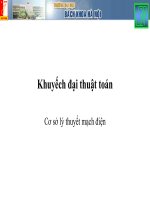Chapter 10: Khuếch đại thuật toán pptx
Bạn đang xem bản rút gọn của tài liệu. Xem và tải ngay bản đầy đủ của tài liệu tại đây (817.79 KB, 45 trang )
Operation amplifier
Symbol
Example
Characteristics
Structure
Operation
Applications
μp 741
Symbol
Example
Characteristics
Characters of circuits depend on outside circuit structure, not the opamp itself
Gain AV: very high, ideally ∞
Zin: very large, ideally ∞
Zout: very small, ideally 0
Current entering the amp at either terminal: extremely small, ideally 0
Voltage out (when voltages into each other are equal): small, ideally 0
Bandwidth: broad, ideally infinite
Characteristics
Input: 2 inputs (positive and negative)
Single-ended input: 1 input to signal source, 1 input to
ground
Double-ended input: 2 different signal sources or 1 signal
source apply between 2 inputs
Output: 1 or 2 outputs, typically 1 output
Mode gain:
Differential-mode gain A
dm
- large
Common-mode gain A
cm
- small
Common-mode rejection ratio CMRR=G=A
dm
/A
cm
, usually
about 10
3
-10
5
Structure
Requirement:
Gain: large
Offset: small
Currents: small
Input impedance: large
Output impedance: small
Input: symmetric
Structure
Input stage
Intermediate stage
Level shifting stage
Output stage
Example: 741 – at the end of chapter
Applications
Basic and advance applications
Basic applications:
Inverting, non-inverting amplifier
Uni-gain circuit
Addition and subtraction circuits
Integration and differential circuits
Multi-stages circuit
Applications
Advance applications
Current-controlled voltage source
Voltage-controlled current source
DC voltmeter
AC voltmeter
Driver circuit
Active filters
NIC
.etc.
Non-inverting fixed-gain amplifier
Prove:
V- = V+ = V1
I- = I+ = 0
=>IR1 = Irf = V1/R1
=>A = 1+Rf/R1
Non-inverting fixed-gain amplifier
A = 1+Rf/R1=101
Vo=101Vi
Inverting fixed-gain amplifier
Prove:
V- = V+ = 0
I- = I+ = 0
=>IR1 = Irf = V1/R1
=>A = -Rf/R1
Voltage addition
Vo = -V1Rf/R1-V2Rf/R2 –V3Rf/R3
If V1=V2=V3 then:
A= -Rf/R1-Rf/R2 –Rf/R3
Voltage subtraction
Vout1 = -Rf/R1V1
Vout = -Rf/R2V2 - Rf/R2Vout1 = -Rf/R2V2 + Rf/R2V1
= -Rf/R2(V1 – V2)
Voltage subtraction with 1 amp
Prove:
V-=V+=V1*R3/(R1+R3)
I- = I+ = 0
=>IR1 = IR4 = V2- V1*R3/(R1+R3)
=>Vo=V1*R3/(R1+R3)*
(R2+R4)/R2 – V2*R4/R2
Uni-gain (buffer) amplifier
Provide required input and output resistant stage
Provide multiple identical output signals
Voltage-controlled voltage source
V
o
=(-R
f
/R
1
)V
1
V
o
=(1+R
f
/R
1
)V
1
Voltage-controlled current source
Io=V1/R1
Current-controlled voltage source
Vo=-I1RL
Current-controlled current source
Io=I1(R2+R1)/R2
Integration circuit
Vo=(Vi/RC)0ƒ
T
Vi(t)dt+Vout(t=0)
Differential circuit
Vo=-RC dVi/dt
Filter
Low pass filter
High pass filter
Band pass filter
1
st
order low pass filter
Cutoff frequency: fOH=1/(2πR 1C1)
Voltage gain below cutoff freq: Av=1+Rf/RG
2
nd
order low pass filter
Cutoff frequency: fOH=1/(2πR 1C1)
Voltage gain below cutoff freq: Av=1+Rf/RG









